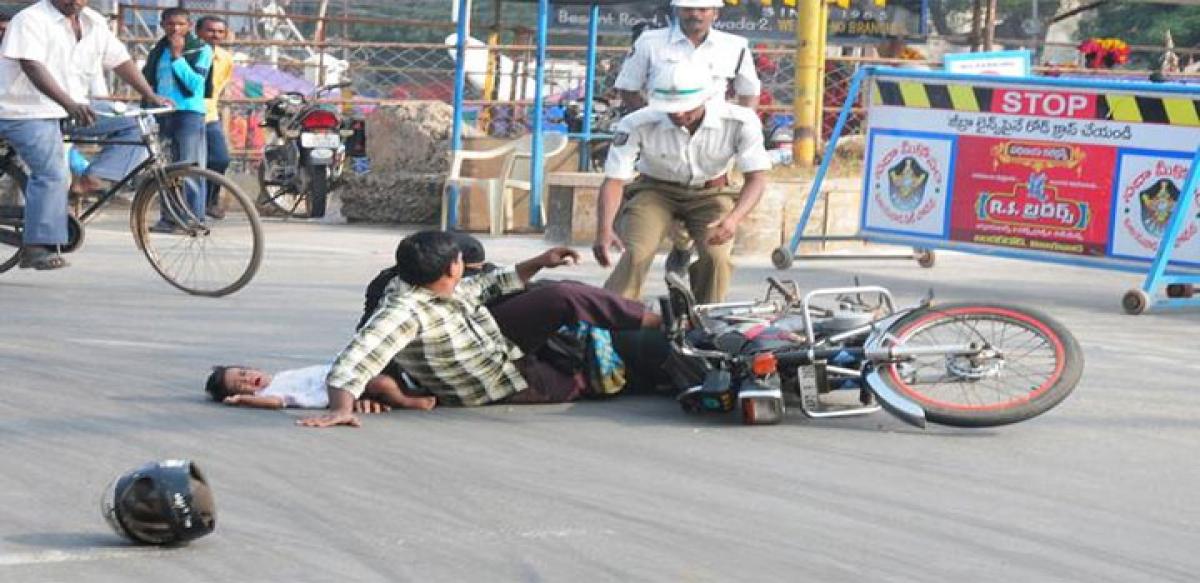Live
- Bengal school jobs case: Arpita Mukherjee granted bail; new HC Bench to look into Partha Chatterjee's plea
- Working to provide social security for gig and platform workers: Govt
- Bangladesh records 11 dengue deaths, toll rises to 459
- Vocera Raises $500K from Y Combinator to Revolutionize Voice AI Testing and Evaluation
- GQG Partners Refuses to Sell Adani Stocks Despite Bribery Scandal and 26% Loss
- Bihar: Four persons including girl injured in post bypolls violence in Gaya
- Dharmasthala Dharmadhikari Enters Record Book
- BJP to Review By-election Losses in State Meet
- Activist Alleges CPCB Cover-up on Endosulfan in Kasaragod
- Theft Case of Thumbe Mahalingeshwara Temple
Just In

Expressing dismay over government’s apparent lack of focus on road safety, the Supreme Court of India as early as 1979 in Ratan Singh vs. State of Punjab said that more people were dying of road accidents than most diseases.
.jpg)
Expressing dismay over government’s apparent lack of focus on road safety, the Supreme Court of India as early as 1979 in Ratan Singh vs. State of Punjab said that more people were dying of road accidents than most diseases.
Indian highways are among the top killers of the country. There are a more number of deaths due to road accidents than from communicable diseases.
India has the dubious distinction of having the highest road-related mortalities in the world. According to the estimates of Ministry of Health and Family Welfare in 2004, road traffic injuries are the sixth lead- ing cause of death in India.
Many factors are endangering road safety which include the State’s misfeasance in the maintenance of roads in good trim, lack of citizens’ consciousness, presence of heavy vehicles beyond the capabilities of the highways system etc.
The state must rise to the gravity of the situation and provide measures like frightening pub- licity for gruesome accidents that create a lurking fear and safety consciousness, strict driving licensing, rigorous vehicle invigilation etc.
The Supreme Court in MC Mehta case has in fact laid down a new principle in jurisprudence by equating the right to be safe on the roads with the right to life. Public safety on roads is within the ambit of Article 21 of the Constitution and so implicates the Right to life.
The World Health Organisation (WHO) has rightly observed that the road accidents are predictable and preventable. Pedestrians, cyclists, motorised two wheeler riders are the most vulnerable to road accidents.
Segregation of road space with dedicated road corridor for high speed vehicles can be one such solution. Studies also reveal that most of the road accidents are occurring in tier-2 cities, district towns, peripheral rural areas and on highways.
Despite rapid increase in traffic on these roads, they are poorly maintained. Road vigil to check unwarranted speed is almost absent.
Emergency health facilities to cater to the victims of road accidents are woefully inadequate, if not nonexistent. The experience of developed countries that have substantially reduced road-related morbidity and mortality reveal three strategic interventions.
They are good and responsible road user behavior, safe roads and safe vehicles. But, India has a lot to achieve on these three fronts. Drivers ride vehicle after consuming alcohol.
There are no speed control mechanisms. There is not even proper signaling to guide drivers on roads. People accused of causing fatal accidents most often go scot-free.
Influential people manipulate even road design to suit their interests even at the cost of road safety. Owners of vehicles exploit the drivers beyond their capacity to drive safely.
India made a whopping allocation of Rs 2,79,000 crore for roads during the eleventh plan period. Exponential increase in number of vehicles made such a massive investment an imperative. But, what is lacking is a political will to prevent this man- made epidemic.

© 2024 Hyderabad Media House Limited/The Hans India. All rights reserved. Powered by hocalwire.com







